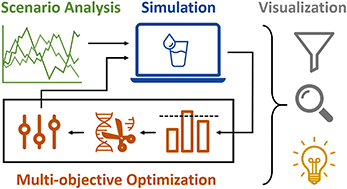当前位置:
X-MOL 学术
›
Environ. Sci.: Water Res. Technol.
›
论文详情
Our official English website, www.x-mol.net, welcomes your feedback! (Note: you will need to create a separate account there.)
Multi-objective optimization of water treatment operations for disinfection byproduct control
Environmental Science: Water Research & Technology ( IF 5 ) Pub Date : 2019/12/23 , DOI: 10.1039/c9ew00850k William J. Raseman 1, 2, 3, 4, 5 , Joseph R. Kasprzyk 3, 4, 5, 6 , R. Scott Summers 3, 4, 5, 6 , Amanda K. Hohner 3, 7, 8, 9 , Fernando L. Rosario-Ortiz 3, 4, 5, 6
Environmental Science: Water Research & Technology ( IF 5 ) Pub Date : 2019/12/23 , DOI: 10.1039/c9ew00850k William J. Raseman 1, 2, 3, 4, 5 , Joseph R. Kasprzyk 3, 4, 5, 6 , R. Scott Summers 3, 4, 5, 6 , Amanda K. Hohner 3, 7, 8, 9 , Fernando L. Rosario-Ortiz 3, 4, 5, 6
Affiliation

|
This paper introduces a novel decision-making framework for the optimization of water treatment plant operations. Managers at water utilities face increasing tensions between cost, public health risk, public perception, and regulatory compliance. Multi-objective optimization techniques have been developed to generate innovative solutions to environmental problems with competing objectives. By integrating these optimization techniques with water quality scenarios, water treatment modeling, and interactive visualization, our framework enables water managers to choose among an ensemble of optimal treatment operations. By automating the generation of treatment options, this paradigm represents a shift toward exploration and insight discovery in drinking water decision making. To illustrate this framework, we create a disinfection byproduct (DBP) management problem that incorporates the influence of competing risks and cost objectives on decision making. Using data from the Cache la Poudre River—a source water in Colorado with seasonally-varying water quality—and a hypothetical conventional treatment plant, we evaluate the impact of organic carbon increases on the performance of optimal treatment operations. These results suggest that the hypothetical utility should consider infrastructural improvements if organic carbon concentrations increase more than approximately 25% of maximum historical levels. An interactive exploration of the optimization results reveal to what extent there are tradeoffs between solids handling costs, chemical costs, and DBP exposure. A k-means clustering of these data illustrates that the utility can achieve compliance through a variety of treatment strategies depending on decision maker preferences for cost and risk.
中文翻译:

用于消毒副产物控制的水处理操作的多目标优化
本文介绍了一种用于优化水处理厂运营的新型决策框架。自来水公司的经理面临着成本,公共健康风险,公众认知和法规遵从之间日益紧张的矛盾。已开发出多目标优化技术,以针对具有竞争目标的环境问题生成创新的解决方案。通过将这些优化技术与水质方案,水处理模型和交互式可视化相集成,我们的框架使水管理者可以在一组最佳处理操作中进行选择。通过自动生成处理方案,该范例代表了饮用水决策中向探索和洞察力发现的转变。为了说明这个框架,我们创建了一个消毒副产品(DBP)管理问题,该问题综合了竞争风险和成本目标对决策的影响。利用Cache la Poudre河(科罗拉多州的水质随季节变化的水)和假设的常规处理厂的数据,我们评估了有机碳增加对最佳处理操作性能的影响。这些结果表明,如果有机碳浓度增加超过最大历史水平的约25%,则假设的效用应考虑基础设施的改善。对优化结果的交互式探索揭示了固体处理成本,化学品成本和DBP暴露之间的权衡程度。一种 利用Cache la Poudre河(科罗拉多州的水质随季节变化的水)和假设的常规处理厂的数据,我们评估了有机碳增加对最佳处理操作性能的影响。这些结果表明,如果有机碳浓度增加超过最大历史水平的约25%,则假设的效用应考虑基础设施的改善。对优化结果的交互式探索揭示了固体处理成本,化学品成本和DBP暴露之间的权衡程度。一种 利用Cache la Poudre河(科罗拉多州的水质随季节变化的水)和假设的常规处理厂的数据,我们评估了有机碳增加对最佳处理操作性能的影响。这些结果表明,如果有机碳浓度增加超过最大历史水平的约25%,则假设的效用应考虑基础设施的改善。对优化结果的交互式探索揭示了固体处理成本,化学品成本和DBP暴露之间的权衡程度。一种 这些结果表明,如果有机碳浓度增加超过最大历史水平的约25%,则假设的效用应考虑基础设施的改善。对优化结果的交互式探索揭示了固体处理成本,化学品成本和DBP暴露之间的权衡程度。一种 这些结果表明,如果有机碳浓度增加超过最大历史水平的约25%,则假设的效用应考虑基础设施的改善。对优化结果的交互式探索揭示了固体处理成本,化学品成本和DBP暴露之间的权衡程度。一种这些数据的k均值聚类表明,公用事业可以通过各种处理策略来实现合规性,具体取决于决策者对成本和风险的偏好。
更新日期:2020-03-05
中文翻译:

用于消毒副产物控制的水处理操作的多目标优化
本文介绍了一种用于优化水处理厂运营的新型决策框架。自来水公司的经理面临着成本,公共健康风险,公众认知和法规遵从之间日益紧张的矛盾。已开发出多目标优化技术,以针对具有竞争目标的环境问题生成创新的解决方案。通过将这些优化技术与水质方案,水处理模型和交互式可视化相集成,我们的框架使水管理者可以在一组最佳处理操作中进行选择。通过自动生成处理方案,该范例代表了饮用水决策中向探索和洞察力发现的转变。为了说明这个框架,我们创建了一个消毒副产品(DBP)管理问题,该问题综合了竞争风险和成本目标对决策的影响。利用Cache la Poudre河(科罗拉多州的水质随季节变化的水)和假设的常规处理厂的数据,我们评估了有机碳增加对最佳处理操作性能的影响。这些结果表明,如果有机碳浓度增加超过最大历史水平的约25%,则假设的效用应考虑基础设施的改善。对优化结果的交互式探索揭示了固体处理成本,化学品成本和DBP暴露之间的权衡程度。一种 利用Cache la Poudre河(科罗拉多州的水质随季节变化的水)和假设的常规处理厂的数据,我们评估了有机碳增加对最佳处理操作性能的影响。这些结果表明,如果有机碳浓度增加超过最大历史水平的约25%,则假设的效用应考虑基础设施的改善。对优化结果的交互式探索揭示了固体处理成本,化学品成本和DBP暴露之间的权衡程度。一种 利用Cache la Poudre河(科罗拉多州的水质随季节变化的水)和假设的常规处理厂的数据,我们评估了有机碳增加对最佳处理操作性能的影响。这些结果表明,如果有机碳浓度增加超过最大历史水平的约25%,则假设的效用应考虑基础设施的改善。对优化结果的交互式探索揭示了固体处理成本,化学品成本和DBP暴露之间的权衡程度。一种 这些结果表明,如果有机碳浓度增加超过最大历史水平的约25%,则假设的效用应考虑基础设施的改善。对优化结果的交互式探索揭示了固体处理成本,化学品成本和DBP暴露之间的权衡程度。一种 这些结果表明,如果有机碳浓度增加超过最大历史水平的约25%,则假设的效用应考虑基础设施的改善。对优化结果的交互式探索揭示了固体处理成本,化学品成本和DBP暴露之间的权衡程度。一种这些数据的k均值聚类表明,公用事业可以通过各种处理策略来实现合规性,具体取决于决策者对成本和风险的偏好。


























 京公网安备 11010802027423号
京公网安备 11010802027423号